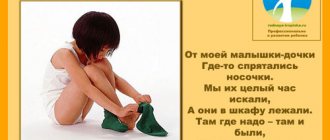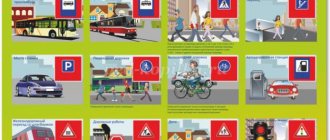Daily routine at preschool educational institution
One of the main tasks of the kindergarten is to satisfy all the needs of the body of preschool children, strengthen their health, and also develop useful cultural and hygienic skills. When compiling a summary of routine moments in the senior group, you can rely on the following table.
| Activity | Time frame (according to the “Origins” program) |
| Reception of children, their examination, free games | 7.00 — 8.20 |
| Charger | 8.20 — 8.30 |
| Breakfast | 8.30 — 9.00 |
| Educational activities along with preparation and breaks | 9.00 — 10.30 |
| Walk | 10.30 — 12.20 |
| Returning to the group, undressing | 12.20 — 12.35 |
| Dinner | 12.35 — 13.00 |
| Quiet hour | 13.00 — 15.00 |
| Lifting and hardening | 15.00 — 15.30 |
| Afternoon snack | 15.30 — 15.50 |
| Free games | 15.50 — 17.00 |
| Walk, children go home | 17.00 — 19.00 |
The teacher should encourage the activity and independence of pupils, organizing their activities at scheduled moments. In the older group, children already know how to wash and dress, and eat food carefully. It is necessary to consolidate the achieved results, and also gradually complicate the tasks.
Preview:
Summary of routine moments in the 1st half of the day in the middle group (morning reception, washing, feeding, preparing for a walk (dressing), returning from a walk (undressing), preparing for bed and going to bed).
Goal: to promote an emotional mood for the whole day, to ensure a calm separation of children from their parents.
Equipment: various toys.
In 10-15 minutes I come to the group, ventilate the room, prepare the toys.
I greet each child kindly and greet him and his parents with a smile. I ask the parents: “How did the child sleep?”, “How is he feeling?”, “In what mood did he go to kindergarten?” or I ask the child himself: “Well, how are you? Will you play with us today?
Then I bring the child into the group and offer him an activity (dolls, cars, cubes, mosaics). During the reception, if the child does not want to part with his parents, I use musical and ).
Goal: promote health, formulate a washing rule.
While the nanny is putting breakfast on the tables, I call 2-3 children who are eating slowly and say: “Guys, do you want your hands to be clean? Let's wash them."
I take the children to the washbasin and say: “We roll up our sleeves so as not to get them wet, and now open the tap with warm water. I make sure (if necessary I help) that the children open the tap. When water started flowing in all the taps, I use a literary word:
Clean water is flowing. We know how to wash with you - We put our hands under the water with a boat (I show it to the children). Now take the soap and lather your hands in a circular motion. They washed their ears with soap, they washed their hands with soap, these are the little hands, little hands, little hands.
— We put our hands under the water again and rinse off the soap well. Shake the remaining water into the sink and turn off the tap. Now everyone goes to the towel and wipes their hands dry on all sides, we hang the towel back in its place. So our hands have become clean!
I also continue to call the remaining children one by one, help them and use artistic expression.
Goal: to promote the formation of rule of behavior at the table.
Conduct: “Children, everyone who has washed their hands, sit down at the tables. Sit up straight, put your legs straight, do not put your elbows on the table. Everyone is sitting upright, Legs are standing together, Eyes are looking at the plate, Elbows are removed from the table, The children are eating quietly. Children! Came to visit today
Came to visit today - Good Appetite! Bon Appetit everyone!"
While eating, I make sure that the children hold the spoon correctly, sit up straight, and eat silently.
I tell you how beneficial it is when children eat: they grow quickly and never get sick.
For children who don't eat, I try to convince them that they need to eat at least a little (unless they have a reason not to eat).
I help those guys who eat slowly or don’t know how to eat.
To the child who has eaten, I say: “Dasha, take a napkin and wipe your mouth, don’t forget to say “thank you” and push up the chair.”
Preparing for a walk (dressing)
Goal: to ensure that all children are ready for a walk on time.
Before going out for a walk, I remind the children to go to the toilet. Then I take a group of children and we all go out to the locker room together.
I make sure that children dress properly for a walk, observing the principle of gradualness: tights, socks, pants, boots, jacket, hat, jacket, mittens, scarf.
During this I use a literary word:
Let's dress in order
We get used to order.
- Danila, what color are your pants?
- Vanya, what do we put on our heads?
If the children cannot answer, I help them.
I encourage the children to dress themselves: “Kolya, show me how you can put on your pants.”
— Children, in order for our clothes to be clean, we need to walk carefully and not run through puddles.
Returning from a walk (undressing)
Goal: to ensure timely arrival from a walk.
I ask all children to wipe their feet when entering kindergarten (I show them how to do this).
- How cheerful you all are when you came back from your walk! Do you want to go to a group to play? Let's carefully undress.
I make sure that all the children undress correctly and neatly, and I help any of the children who need help.
- First we take off the jacket, then the hat, jacket, pants, boots, tights and, finally, socks.
I make sure the children are neat after a walk: “Dasha, look how dirty your pants are!” What kind of pants did you wear?” (clean).
I also turn to other children: “Yulia, what are you filming now? Christina, where will you hang your jacket?”
Goal: to contribute to the formation of rules of conduct.
I take the children one by one to the toilet, then to the bedroom.
- Guys, we played so well today and our hands, eyes and legs are tired and want to rest. Take your chairs and let's undress. Children, does everyone remember how to fold their clothes on a chair? I help the children undress. I put the children in bed first because they take longer to fall asleep. Let's put a soft feather bed under the back. On top of the feather bed, a clean sheet. Put white pillows under the ears. And cover with a blanket so that the children sleep soundly.
- Guys, who have undressed, lie down in bed and cover yourself with a blanket. When all the children are lying in bed, I say in a calm, quiet voice: So people are sleeping, Here are animals sleeping. Birds sleep on branches, Foxes sleep on hills, Hares sleep on grass, Ducks sleep on ants, Children are all in their cradle... They sleep and sleep, they tell the whole world to sleep. Now we lie down on our side and close our eyes. Pleasant dreams! While the children are sleeping, I keep an eye on them (so that they don’t open up, so that they don’t fall).
Card index of cultural and hygienic skills in the senior group
Long-term plan for the education of cultural and hygienic skills
Reading: I. Ishchuk “My Palms”
Keeping clothes and shoes in order, making the bed.
Learn to dry and clean your clothes and shoes, strengthen the ability to make your bed
Didactic exercise “How to make the bed.”
Learn to eat different types of food without changing the position of the fork in your hand, but only slightly turning your hand.
Reading N. Litvinov “The Kingdom of Cutlery.”
Improve the skills of correctly placing your things in the closet, strengthen the ability to tie shoelaces, and fasten sandals.
Conversation “Every thing has its place.”
Improve your washing skills, wash your face, and dry yourself with an individual towel.
Didactic exercise “Let’s tell the kids how to wash themselves.”
Continue learning how to make the bed: straighten the blanket after adjusting the sheet.
Reading S. Mikhalkov “I myself.”
Strengthen the ability to spread butter on bread with a knife, cut off a piece of meat or sausage.
Didactic exercise “Let’s tell the kids how to use a knife correctly”
Strengthen the ability to dress and undress in a certain sequence, use different types of fasteners.
Reading I. Bursov “Galoshes”, S. Mikhalkov “I Myself”.
Exercise “Who will put the clothes correctly and quickly.”
Continue to teach how to wash yourself properly and use a handkerchief in a timely manner.
Reading K. Chukovsky “Moidodyr” (excerpts).
Improve the skills of making the bed, the ability to carefully cover the bed with a blanket.
Didactic exercise “Who will make the bed correctly and quickly.”
Conversation “How to properly eat a second course.”
Strengthen the ability to neatly fold and hang clothes on a chair, and dress in a certain sequence.
Exercise “How we can put things in order.”
Improve the skills of proper washing and using an individual towel.
Reading A. Barto, P. Barto “The Dirty Girl”.
Keeping clothes and shoes in order, making the bed.
Continue to teach how to dry and clean your clothes and wipe your shoes
Conversation “How to take care of your clothes.”
Strengthen the ability to eat the second course.
Improve your ability to use a napkin as needed.
Conversation “Culture of behavior while eating.”
Teach children to independently maintain cleanliness and order in their closet.
Conversation “How we clean up our closet”
Improve your ability to wash your face quickly and correctly.


